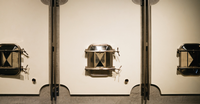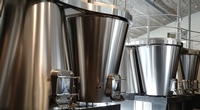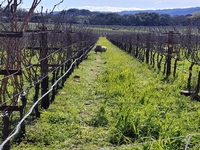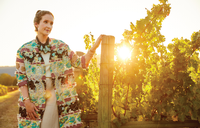In 1996, Leslie Rudd and his wife, Susan, picked a 56-acre vineyard site in Oakville located where the Oakville Crossroad meets the Silverado Trail. The soil on this site is mostly volcanic with some clay and sand. The reddish color of much of the soil points to its richness with iron. This vineyard is planted  with Cabernet Sauvignon, Cabernet Franc, Petit Verdot and Malbec. He also found a vineyard site suitable for Sauvignon Blanc, Semillon and Sauvignon Gris at 1600 feet on Mt. Veeder.
with Cabernet Sauvignon, Cabernet Franc, Petit Verdot and Malbec. He also found a vineyard site suitable for Sauvignon Blanc, Semillon and Sauvignon Gris at 1600 feet on Mt. Veeder.
As he found his vineyard sites and planned his winery, he relied upon the skill and experience of a few experts to guide him. These experts have in common a respect for traditional methods in the vineyard and the winery and a willingness to adopt modern techniques…when they prove to enhance wine quality. Château Haut-Brion was Rudd’s vision of a wine estate, so he looked to Jean-Bernard Delmas, who was technical director of that property until 2003, for advice and inspiration. Château Pétrus in Pomerol–where Olivier Berrouet was winemaker from 1970 to 2008–uses concrete tanks for fermenting their wines. Rudd’s concrete tanks were built on-site by the designer and mason of Petrus’s tanks, using 60 tons of their vineyard rocks. The late Loire Valley iconoclast, Didier Dagueneau, advised him on the Mt. Veeder vineyard. David Ramey, Rudd’s winemaker from 1998  to 2002, came from Dominus Estate in Napa Valley, owned by Christian Moueix, who managed Petrus from 1970 to 2008.
to 2002, came from Dominus Estate in Napa Valley, owned by Christian Moueix, who managed Petrus from 1970 to 2008.
The winery was built to allow versatility in handling grapes to maximize the expression of their place in the vineyard. The winery is called the Workshop, because, well, it is. I visited last year during a quiet time for wineries, so it was more like a museum of modern and traditional wine making. Fermentation vessels, including shiny, French cone-shaped, stainless-steel tanks, shared space with  the aforementioned concrete tanks, concrete eggs and amphorae. Grapes are picked and handled in the winery by vineyard plot. A tasting of a few samples of wines coming from grapes grown in different plots demonstrated the effect of location and the diversity of flavor profiles available for blending into their final wines.
the aforementioned concrete tanks, concrete eggs and amphorae. Grapes are picked and handled in the winery by vineyard plot. A tasting of a few samples of wines coming from grapes grown in different plots demonstrated the effect of location and the diversity of flavor profiles available for blending into their final wines.
I met winemaker Frederick Ammons and vineyard manger Macy Stubstad at the estate. We walked in the vineyards lush with cover crops and with an  occasional sheep–their natural lawn mower. Most wineries will say their wines begin in the vineyard. Some are more dedicated to that concept than others. Rudd is farming organically and biodynamically, a holistic approach to the health of their vineyards. Perhaps the biggest benefit of this type of farming, aside from the elimination of chemical fertilizers, herbicides and fungicides, is the amount of attention the vines receive the from eyes and hands of skilled workers. Stubstad said that they have a full-time, in-house vineyard team. Each team member is assigned to 10 vine rows to farm, so they know their vines well enough to notice potential problems and react before they become real problems.
occasional sheep–their natural lawn mower. Most wineries will say their wines begin in the vineyard. Some are more dedicated to that concept than others. Rudd is farming organically and biodynamically, a holistic approach to the health of their vineyards. Perhaps the biggest benefit of this type of farming, aside from the elimination of chemical fertilizers, herbicides and fungicides, is the amount of attention the vines receive the from eyes and hands of skilled workers. Stubstad said that they have a full-time, in-house vineyard team. Each team member is assigned to 10 vine rows to farm, so they know their vines well enough to notice potential problems and react before they become real problems.
Rather than buying new vines from a commercial nursery to replace old or diseased vines, they created an in-house nursery. They create new vines with cuttings from select vines in their vineyards using the traditional practice of massal selection. A grower will pick cuttings from vines that have proven to be disease resistant, or grows well in a certain environment, or has a desired flavor profile. It is a practice that predates commercial vine nurseries and clonal development.
I was delighted that visit included a tasting of two of the estate’s wines. Rudd, Oakville – Napa Valley “Samantha’s” Cabernet Sauvignon 2014 ($174) is named for Rudd’s daughter. Ammons said the Samantha’s Cab really expresses the grape variety. I liked the flavors of this wine more than the aromas, perhaps because the aromas seemed muted. In the mouth, the blackberry and cassis fruit is round and lush with a touch of floral notes. The fruit is well integrated with the fine tannins and in balance with the acidity and alcohol–a seamless wine. Rudd, Napa Valley, Oakville Estate 2013 ($246), the winery’s top wine, is Cabernet Sauvignon dominant at 79 percent, ten percent Cabernet Franc, six percent Malbec and five percent Petite Verdot. Here the focus is on structure and the interplay between the rich black fruit with dried herbal note, the freshness brought by lively acidity and the framework of burnished tannins.
Sadly, a few months after my visit, Leslie Rudd died. In the tradition of grand estates that have survived for generations, his daughter, Samantha is now in charge. According to her bio, at the age of nine, she promised her father she  would continue his vision and strive to leave to the next generation an estate better than she found it. She prepared herself by working with her father for 20 years. She also worked at other wine estates including two owned by women, Château Margaux and Spottswoode. Her return to the winery led to an increased focus on organics with the addition of biodynamic practices in the vineyards and the introduction of two new wines.
would continue his vision and strive to leave to the next generation an estate better than she found it. She prepared herself by working with her father for 20 years. She also worked at other wine estates including two owned by women, Château Margaux and Spottswoode. Her return to the winery led to an increased focus on organics with the addition of biodynamic practices in the vineyards and the introduction of two new wines.
I got to taste those new wines, called Crossroads, along with other Rudd wines with Oscar Henquet, Managing Director, when he came to Dallas a couple of months ago. While the Crossroads name is not new to Rudd, Samantha Rudd is bringing the name back with a fun new label depicting the crossed roads of the Oakville AVA. It is a second label made from grapes intended for the estate wines, but that didn’t quite make the cut for the estate label wines. Nothing wrong with them, they just don’t fit the vintage profile. Crossroads wines are made to be ready to drink earlier than the estate wines and to sell for a lower price.
Rudd, Mt. Veeder – Napa Valley “Crossroads” Sauvignon Blanc 2017 ($30) includes a bit of Semillon and Sauvignon Gris. It has refreshing, citrus and white peach flavors, subtle fresh herbs, and a bit of flintiness made vibrant from snappy acidity. It is a serious wine, yet eminently drinkable.
Rudd, Oakville – Napa Valley “Crossroads” Cabernet Sauvignon 2016 ($80) shows characteristically beautiful Oakville black currant fruit with dark chocolate notes, lush in the mouth tempered by fresh acidity and finishing with supple tannins.
I also had the opportunity taste the Oakville Estate and Samantha’s Cabernet Sauvignon from the 2015 vintage, Rudd’s earliest harvest for Cabernet Sauvignon. It was also the first vintage farmed entirely by their in-house team.
Rudd, Oakville – Napa Valley Estate 2015 ($245) is primarily Cabernet Sauvignon, 94 percent, with added complexity from three percent Cabernet Franc, two percent Petite Verdot and one percent Malbec. It is a tightly structured wine with concentrated blackberry, black cherry and cassis fruit, layered with fresh herbal and floral notes, and a touch of Asian spice. The rich fruit is balanced with vibrant acidity and ripe tannins. It is a tight, powerful wine that could use more time in the bottle, but it should go on gracefully for decades.
The spotlight for Rudd, Oakville – Napa Valley “Samantha’s” Cabernet Sauvignon 2015 ($175) is on the succulent blackberry, black currant, fruit–with bright acidity keeping it fresh. It is full-bodied, juicy, savory and toasty with vivid acidity, finishing with sleek tannins. Drinkable now, but there’s plenty of structure for aging another 10 to 12 years.
Leslie Rudd had the vision and resources to create a great wine estate in a great terroir. He received guidance from like-minded people at the highest levels of the wine world. He assembled the people who understood his vision and who have done their part to achieve it. The second generation has taken on the challenge of building on that vision with a promise to make it better. It is inspiring to see the ways that creators of fine wines work to accomplish their mission that is so evident in the level of commitment of the Rudd team. It is very rewarding to experience the results of their efforts.
